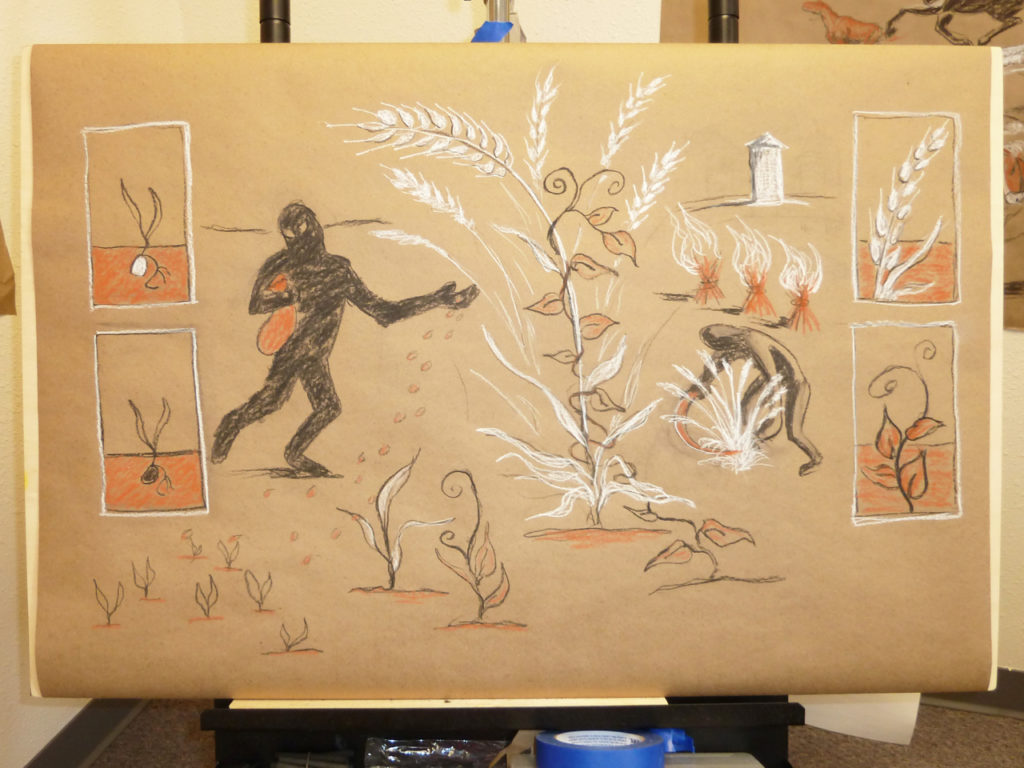The Parable of the Wheat and the Weeds is one of my personal favorites as it seems to capture the confusing nature of the the present age: good and evil mixed together, often indistinguishably.
A farmer sows good seed, but his enemy comes at night and sows weeds. (The weed is thought to be darnel, which looks like wheat but if ground with it will spoil the flour. The King James translates the word as “tares.”) The farmer tells his servants not to pull up the weeds because in doing so “‘you may uproot the wheat with them. Let both grow together until the harvest. At that time I will tell the harvesters: First collect the weeds and tie them in bundles to be burned; then gather the wheat and bring it into my barn.’”
The parable is one of the seven kingdom parables in Matthew 13, one of only two with a title given in the Biblical text (Jesus’ disciples call it “the parable of the weeds in the field”) and one of only three that Jesus explains.
According to Jesus, two types of seed are the people of the kingdom (sown by the Son of Man) and the people of the evil one (sown by the devil). At the end of the age, the angels will “weed out of [God’s] kingdom everything that causes sin and all who do evil.”
In his discussion of the parable in Stories with Intent, Klyne Snodgrass says that “God is not the only one at work, and not all actions in this world can be attributed to God.… Evil happens that can only be identified as the work of an enemy” (p. 215). This is such an important corrective to the “everything happens for a reason” theology circulating in the church today.
Naomi’s drawing (as always, drawn during the class with occasional input from other members) shows the enemy (dressed in black) at the left sowing the bad seed. At the right, another figure is harvesting the wheat with a sickle while stacks of weeds burn behind him. Four insets show how the two different plants look identical when they are young but very different when fully grown. At the center, the weed wraps itself around the wheat.
More Art
Almost all of the Wheat and Weeds artwork I found focuses on the enemy sowing weeds. Exceptions include a 1992 triptych by Dinah Roe Kendall (Wheat and Weeds), and Scott Freeman’s The Parable of the Weeds Among the Wheat, which appears to depict Jesus sowing wheat.
A few pieces focus on the harvest/judgment, including William Blake’s The Good Farmer, Probably the Parable of the Wheat and the Tares, James B. Janknegt’s Grain and Weeds (2002), Scott Freeman’s The Parable of the Weeds, and Bassano-Schule’s The Parable of the Tares (17th Century). Eugène Burnand illustrated The Tares with three drawings, two of which focus on burning the weeds.
The weed-sowing artwork includes:
- Felicien Rops. Satan Sowing Weeds (c. 1872).
- Lucas van Gassel. The Parable of the Wheat and the Tares (1540).
- Unknown. Parable of the Enemy Sowing Tares (1894).
- John Everett Millais’ The Tares.
- Albin Egger-Lienz. Sower and the Devil (1921).
- Abraham Bloemaert. Landscape with the Parable of the Tares (1624).
- Abraham Bloemaert. The Parable of the Tares (1604).
- Crispijn de Passe the elder. The Parable of the Tares (1604).
- Domenico Fetti. Satan Sowing Darnel (17th Century).
- Domenico Fetti. The Parable of the Weeds (c. 1622).
- Jan Luyken. Parable of the Weeds.
- The Enemy Sowing Weeds (c. 1540).
- James Tissot. The Enemy Who Sows (c. 1886-1894)
Music
In addition to “Where Is the Kingdom” (AJS #1) we sang two other songs from And Jesus Said: “Wheat and Weeds” (AJS #12 & 13) and “Mixed Like Weeds in Wheatfields” (AJS #14). Neither recounts the story in the parable. The former (with lyrics by Richard Leach and set to two different tunes) is four lines long:
Wheat and weeds: growing time; wheat alone: harvest come.
Truth and lies, hope and rage, love and fear: wheat and weeds.
Lies pulled up, rage consumed, fear cast out: harvest time.
Truth along, hope fulfilled, love enthroned: kingdom come.
“Mixed Like Weeds in Wheatfields” (with lyrics by Carl Daw) sets Jesus ministry into the context of “worldly power, undaunted” that opposes it. “Though such evils flourish and grounds for hope decrease, deep and well our planted God’s seeds of love and peace.”
This is the sixth post in a series about the Parables of Jesus Sunday school class I co-taught at Trinity CRC in Ames. In each post, I make a few observations about the parable, share Naomi Friend’s original artwork she drew during our class, post links to other art about the parable, and share our favorite songs about the parable. Previous posts covered the Parable of the Sower, The Parables of the Mustard Seed & the Leaven, The Parables of the Hidden Treasure and the Pearl of Great Price, The Lost Sheep and the Lost Coin, and The Parable of the Lost Sons.
